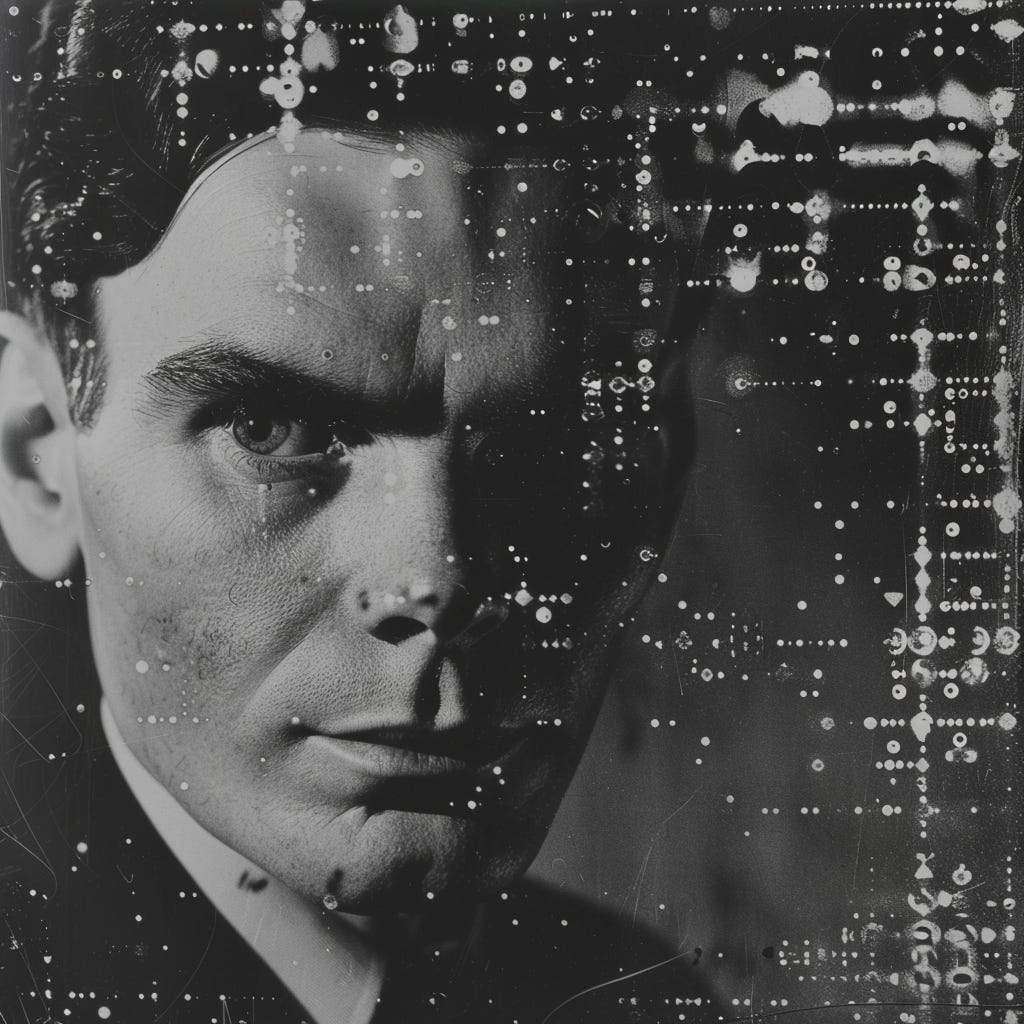This is a guest post by one of my favorite writers,
from . I’m priviledged to bring you a deep dive into the many facets of the man behind some of the most important scientific discoveries in the last century, and the undisputable founding father of the youngest of the major sciences.Nick writes on crucial topics at the intersection of artificial intelligence and education. Subscribe to
to read more of his work.— Alejandro Piad Morffis
By
.
I have been deeply reflecting on Alan Turing lately, especially in the context of this third era of Artificial Intelligence. Recently, I delved into Aaron Hodges’s classic biography of Turing, a monumental work that took me the better part of a month to absorb thoroughly.
Hodges, a quantum physicist who studied under Roger Penrose and was active in the Gay Rights movement within the English academy during the late 1970s, stumbled upon Turing’s story through his activism. This discovery launched him into a rigorous six-year investigation, piecing together the extraordinary life of a man who left behind a surprisingly sparse historical footprint. Hodges's method—rooted in a blend of interviews and exhaustive archival work—culminated in what has been heralded as “a new kind of biography,” weaving together mathematics, science, computing, war history, philosophy, and gay liberation into a singular narrative of a complex individual.
As I navigate the landscape of the third AI era, I am struck by the stark contrast between the unassertiveness of Turing’s public persona and the definitive proclamations flooding our current discourse. Educators wholeheartedly reject AI in classrooms or endorse wholesale handover of curricula to algorithms. Product designers and builders tout their creations as revolutionary, as epochal as the internet itself, while consultants offer ironclad guarantees of success. Consultants jockey to position themselves as experts in a field that is continuously evolving and changing.
In the magisterial final chapter of his biography, Hodges portrays Turing as a figure of “iconoclastic originality.” Yet, Turing himself never sought the limelight or hawked his achievements. He did not deal in guarantees about the future, nor did he ever tether himself too long to any single project. This humility and restraint seem all the more poignant when juxtaposed with the current era’s rush towards an AI-integrated future, often championed with a certainty that Turing would likely have questioned.
Alan Turing: An Immersive, Experiential Worker
First and foremost, Alan Turing was an immersive and experiential worker. He delved deeply into every project, thoroughly understanding its nuances. Hodges emphasizes throughout the biography that Turing never quite fit the traditional academic mold, preferring instead to test theories through practical application. As a teenager, Turing's fascination with chemistry led him to study the gaseous emissions of rotting seaweed. Later, as a mathematician, his wartime code-breaking work provided a foundation of practical skills that he applied in the development of early computers in the late 1940s.
Turing’s hands-on approach offers a cautionary lens through which to view the current enthusiasm for "language" coding with LLM chatbots. Perhaps if we as AI literacy experts fail to engage directly with coding, or at least with platforms like GitHub where the process becomes more visible and discrete, we risk detaching ourselves from a crucial level of experience with these new tools. The irony is palpable: social media is awash with self-proclaimed AI experts, yet only a few truly understand the inner workings of these technologies. Here, dear readers, I acknowledge my own gaps in knowledge as much as anyone’s—and it's why I'm gearing up to take coding classes this summer.
Extended Periods of Deep Immersion Fueling Extraordinary Bursts of Imagination and Creative Achievement
Turing's extended periods of deep immersion fueled extraordinary bursts of imagination and creative achievement. I would like to highlight a few of Turing's remarkable and imaginative breakthroughs:
The Halting Problem: Validity vs. Veracity
In the mid-1930s, Turing's deep engagement with set theory and Gödel's incompleteness theorem, combined with his profound affection for mechanical devices, set the stage for his seminal breakthroughs. Focusing on the "Entscheidungsproblem," which challenges the existence of an algorithm to determine the universal validity of statements in first-order logic, Turing addressed this through his work on the halting problem.
In 1936, he ingeniously demonstrated that no such algorithm could exist, using a hypothetical solution and designing a special Turing machine to expose inherent contradictions. Check out this video for an amusing, but accurate explanation. This fusion of theoretical mathematics and practical insight not only propelled Turing’s own groundbreaking contributions but also laid the foundational framework for modern computing and the discipline of computer science.
Practical Computing: Finite Solutions
In the mid-1940s, Turing applied the lessons he learned from code-breaking and developing voice-encryption machines like Delilah to the practical task of building the first computer. The resulting machine, the Ace, proved to be exceptionally powerful. Yet, much like during his wartime projects, Turing found himself increasingly marginalized from the project's core team, due to his reluctance to wield power and promote himself. Instead, Turing thrived on direct interaction with the Ace, becoming its most adept operator.

Observers often likened him to a concert organist as he masterfully manipulated its dials and gears. During this period, Turing also penned his most visionary thoughts on the future of computing, transitioning his focus from universal to finite machines and highlighting the potential of limited memory and storage. It was while programming the Ace that he first formulated the idea of machine learning.
Morphogenesis: The Mathematics of Life
In the late 1940s and early 1950s, Alan Turing revisited his lifelong fascination with nature by exploring the formation of patterns in biological matter. From a young age, Turing had observed the Fibonacci sequence manifesting in various natural forms, such as leaves, shells, pinecones, and flowers. Like many scientists of his era, he sought to explain these patterns at the molecular level.
Turing hypothesized that morphogenetic fields might influence the development of chemical solutions, guiding their pattern formation. His experimental approach combined mathematics with tightly defined chemical states, focusing on scenarios involving one to four molecules.
The numerical complexity of these interactions quickly exceeded the computational capabilities of the era's early computers, challenging Turing to balance intricate theoretical constructs with the practical limitations of technology. Turing's exploration into the patterning of biological matter marked his final project and evidenced a mind that remained vitally active, perpetually in search of its next major endeavor.

In each of these ventures, Turing derived little personal gain from his extensive experiments and labors. Though he occasionally ascended to positions of influence, he readily relinquished them whenever they hindered his pursuit of a compelling idea or project. Turing's approach starkly contrasts with the highly commercialized landscape of today's AI industry. This begs the question: how many groundbreaking ideas are we losing in our haste to transform them into marketable, viral, and transactional products? Turing’s example challenges us to reflect on the true cost of prioritizing profit over the unbridled pursuit of knowledge.
The Profound Creative Insights Stemming from Turing's Immersive Work Habits Were Underpinned by What Might Be His Most Crucial Trait: A Resolute Detachment from Criticism
This Stoic indifference—the essence of what Hodges refers to as Turing’s "iconoclastic originality"—is central not only to his intellectual freedom but also to the great tragedy that overshadowed his life.
Turing's indifference shielded him from the harsh criticisms of family, public school teachers, professors, and employers. Choosing not to follow a traditional academic path, Turing didn't receive the accolades that many of his contemporaries did. His pivotal contributions to the war effort could not be recognized during his lifetime, and for years after his death, he was remembered primarily for resolving Hilbert's 10th problem. It wasn't until the rediscovery and renaissance of his work in the 1960s and 1970s, as his visions of a computer age were realized, that his true impact began to be appreciated.
In the 1940s, Turing was relatively open about his homosexuality with friends, colleagues, and employers. His forthright nature led to severe consequences after he reported a theft by the friend of a lover, inadvertently exposing himself to criminal charges.
Choosing hormone treatment over imprisonment, Turing continued to pursue his personal and professional life unabated, traveling to Sweden to be with a lover. Hodges speculates that Turing’s liaisons attracted intense scrutiny from the British government, possibly playing a role in Turing’s untimely death via suicide, though historical records on this are scant.
We ought to approach the task of distilling the intricate circumstances of Turing’s life into digestible insights with considerable caution. Yet, it's undeniable that there is something profoundly remarkable and admirable about Turing's steadfast resistance to external pressures.
Unlike so many of us in this digital age, Turing was not swayed by rumors, hype, personal gain, or even comfort. He was a stalwart figure, embodying honor and ethical integrity—an emblematic figure for us as we navigate the complexities of the 3rd AI Era.
How do we stand firm against the latest news cycle?
Are we cultivating a posture of resoluteness that allows us to commit to truly impactful work?
These are the questions that Turing's legacy prompts us to consider today.
Thank you for reading this piece. If you found it meaningful, please leave a note. And consider exploring Hodges’s biography to delve deeper into the life of this remarkable individual.
By contrast, we find ourselves carried this way and that depending upon the changing winds of the news cycles and each other’s opinions.
For more captivating insights into how artificial intelligence is reshaping the way we teach, work, write, communicate, and uphold our humanity, subscribe to my Substack
. Please consider becoming a paid subscriber so that I can continue to publish incredible content for my readers every Monday. I am always excited to hear from my readers!!!Drop me a line at potkalitsky@gmail.com.








